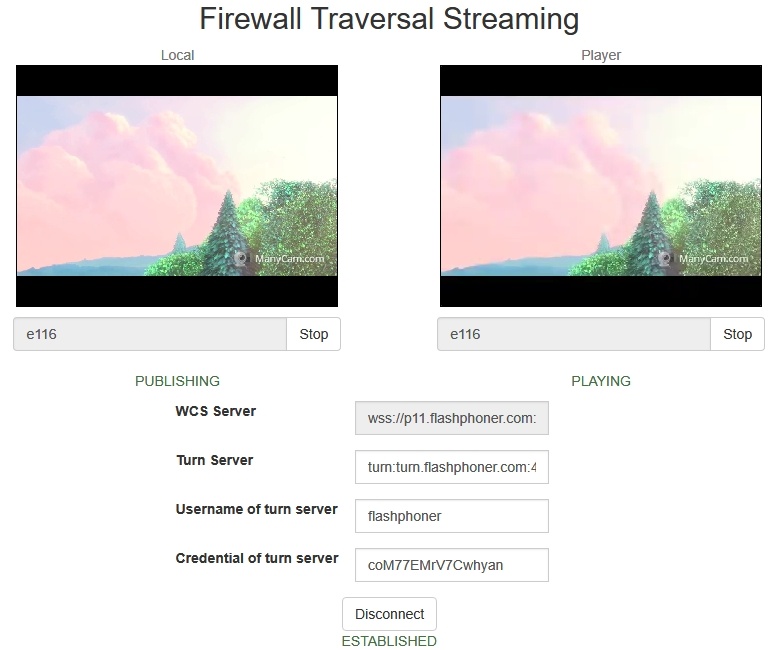The example of firewall traversal video streaming and playback using TURN server. It works in all browsers except Microsoft Edge because this browser do not support TURN over TCP.
The code of the example
The source code of the example is on WCS server by this path:
/usr/local/FlashphonerWebCallServer/client2/examples/demo/streaming/firewall-traversal-streaming/
firewall-traversal-streaming.css - CSS style file
firewall-traversal-streaming.html - the example page
firewall-traversal-streaming.js - script for example to work
The example may be tested at this URL:
https://host:8888/client2/examples/demo/streaming/firewall-traversal-streaming/firewall-traversal-streaming.html
where host is your WCS server address.
Analyzing the code
To analyze the code get firewall-traversal-streaming.js file version with hash c306c1bbf49bfcbd8e24be927ae95f63b7dbaaba that can be found here and is available to download in build 0.5.28.2747.
1. API initializing.
Flashphoner.init() code
Flashphoner.init({flashMediaProviderSwfLocation: '../../../../media-provider.swf'});
2. Connection to the server.
Flashphoner.createSession() code
These parameters are passed to createSession() method:
- WCS server URL
- TURN server URL
- TURN server user credentials
Flashphoner.createSession({
urlServer: url,
mediaOptions: {
"iceServers": [
{
'url': $('#urlTurnServer').val(),
'username': $('#usernameTurnServer').val(),
'credential': $('#credentialTurnServer').val()
}
]
}
...
});
3. Receiving the event confirming successful connection
ConnectionStatusEvent ESTABLISHED code
Flashphoner.createSession({
...
}).on(SESSION_STATUS.ESTABLISHED, function (session) {
setStatus("#connectStatus", session.status());
onConnected(session);
}).on(SESSION_STATUS.DISCONNECTED, function () {
...
}).on(SESSION_STATUS.FAILED, function () {
...
});
4. Video streaming
session.createStream(), publish() code
These parameters are passed to createStream() method:
- streamName - the stream name
- localVideo - <div> element to display preview stream.
session.createStream({
name: streamName,
display: localVideo,
cacheLocalResources: true,
receiveVideo: false,
receiveAudio: false
...
}).publish();
5.Receiving the event confirming successful streaming
StreamStatusEvent PUBLISHING code
session.createStream({
name: streamName,
display: localVideo,
cacheLocalResources: true,
receiveVideo: false,
receiveAudio: false
}).on(STREAM_STATUS.PUBLISHING, function (stream) {
setStatus("#publishStatus", STREAM_STATUS.PUBLISHING);
onPublishing(stream);
}).on(STREAM_STATUS.UNPUBLISHED, function () {
...
}).on(STREAM_STATUS.FAILED, function () {
...
}).publish();
6. Stream playback
session.createStream(), play() code
These parameters are passed to createStream() method:
- streamName - the stream name (including the stream published on step above)
- remoteVideo - <div> element to display stream playback.
session.createStream({
name: streamName,
display: remoteVideo
...
}).play();
7. Receiving the event confirming successful stream playback
StreamStatusEvent PLAYING code
session.createStream({
name: streamName,
display: remoteVideo
}).on(STREAM_STATUS.PLAYING, function (stream) {
document.getElementById(stream.id()).addEventListener('resize', function (event) {
resizeVideo(event.target);
});
setStatus("#playStatus", stream.status());
onPlaying(stream);
}).on(STREAM_STATUS.STOPPED, function () {
...
}).on(STREAM_STATUS.FAILED, function () {
...
}).play();
8. Stream playback stop
stream.stop() code
function onPlaying(stream) {
$("#playBtn").text("Stop").off('click').click(function () {
$(this).prop('disabled', true);
stream.stop();
}).prop('disabled', false);
}
9. Receiving the event confirming successful playback stop
StreamStatusEvent STOPPED code
session.createStream({
name: streamName,
display: remoteVideo
}).on(STREAM_STATUS.PLAYING, function (stream) {
...
}).on(STREAM_STATUS.STOPPED, function () {
setStatus("#playStatus", STREAM_STATUS.STOPPED);
onStopped();
}).on(STREAM_STATUS.FAILED, function () {
...
}).play();
10. Streaming stop
stream.stop(). code
function onPublishing(stream) {
$("#publishBtn").text("Stop").off('click').click(function () {
$(this).prop('disabled', true);
stream.stop();
}).prop('disabled', false);
}
11. Receiving the event confirming successful streaming stop
StreamStatusEvent UNPUBLISHED code
session.createStream({
name: streamName,
display: localVideo,
cacheLocalResources: true,
receiveVideo: false,
receiveAudio: false
}).on(STREAM_STATUS.PUBLISHING, function (stream) {
...
}).on(STREAM_STATUS.UNPUBLISHED, function () {
setStatus("#publishStatus", STREAM_STATUS.UNPUBLISHED);
onUnpublished();
}).on(STREAM_STATUS.FAILED, function () {
...
}).publish();
